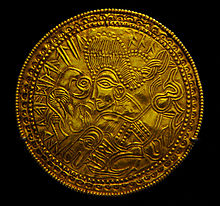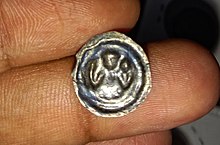Bracteate
A bracteate (from the Latin bractea, a thin piece of metal) is a flat, thin, single-sided gold medal worn as jewelry that was produced in Northern Europe predominantly during the Migration Period of the Germanic Iron Age (including the Vendel era in Sweden).
Bead-rimmed and fitted with a loop, most were intended to be worn suspended by a string around the neck, supposedly as an amulet.
The gold for the bracteates came from coins paid as peace money by the Roman Empire to their Northern Germanic neighbors.
[1] Many of the bracteates feature ruler portraits of Germanic kings with characteristic hair that is plaited back and depictions of figures from Germanic mythology influenced to varying extents by Roman coinage while others feature entirely new motifs.
[1] The typology for bracteates divides them into several letter-named categories, a system introduced in an 1855 treatise by the Danish numismatist Christian Jürgensen Thomsen named Om Guldbracteaterne og Bracteaternes tidligste Brug som Mynt and finally defined formally by the Swedish numismatist Oscar Montelius in his 1869 treatise Från jernåldern: More than 1,000 Migration Period bracteates of type A-, B-, C-, D-, and F are known in total (Heizmann & Axboe 2011).
The bracteates were usually called back regularly, about once or twice a year, and had to be exchanged for new coins (Renovatio Monetae).
This disruption disturbed the business interests of all those who were involved in the then money economy, namely the merchants who dominated in the German city leagues.



